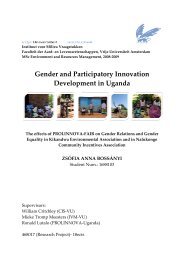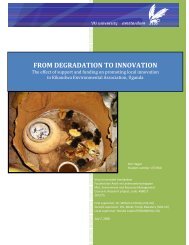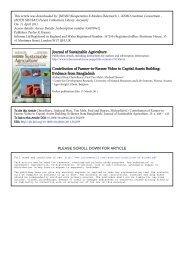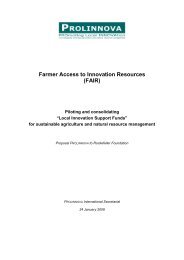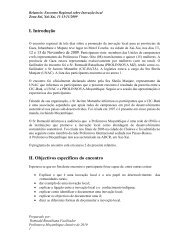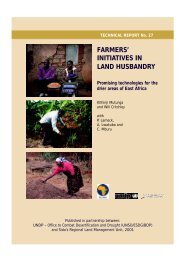Chowdhury et al (2010); PDF file - Prolinnova
Chowdhury et al (2010); PDF file - Prolinnova
Chowdhury et al (2010); PDF file - Prolinnova
Create successful ePaper yourself
Turn your PDF publications into a flip-book with our unique Google optimized e-Paper software.
Comparing Two Styles of Participatory Video 363<br />
each SWOT group and the points on each line show the v<strong>al</strong>ue of each factor within<br />
the group.<br />
Downloaded By: [Vienna University Library] At: 20:39 7 January 2011<br />
1. Perceptions of the Usefulness of Scripted Video<br />
Farmers and facilitators thought the positive factors of the scripted video outweighed<br />
the negative factors. Both farmers and facilitators perceived the capacity-building<br />
function as the major strength of the scripted style. Their underlying argument was<br />
that a script and profession<strong>al</strong> handling of the camera helped document key messages<br />
by making use of the qu<strong>al</strong>ity of visu<strong>al</strong>ization techniques. The outcome, i.e. the film,<br />
had potenti<strong>al</strong> uses for training and educating farmers.<br />
The experience in video development activities indicates that the loc<strong>al</strong> techniques<br />
of eggplant seed production were b<strong>et</strong>ter documented when the camera was handled<br />
by a profession<strong>al</strong>. Profession<strong>al</strong> handling of the camera and planning <strong>al</strong>ong the script<br />
facilitated visu<strong>al</strong>ization of the seed processing techniques. The script helped the RT to<br />
select appropriate fields, materi<strong>al</strong>s (mature and ripe fruit) and farmers to visu<strong>al</strong>ize the<br />
object and learning issues accurately. Without a script, important considerations<br />
such as specific maturity and harvesting periods in the given loc<strong>al</strong>ity might otherwise<br />
be missed out, losing the qu<strong>al</strong>ity of visu<strong>al</strong>ization.<br />
When video profession<strong>al</strong>s were involved and a script was used, the process of<br />
shooting appeared to accentuate the qu<strong>al</strong>ity of the fin<strong>al</strong> film. Once when a fem<strong>al</strong>e<br />
seed processor could not narrate the story in the expected language, the facilitator<br />
team replaced her by another fem<strong>al</strong>e participant. This helped to tell the message<br />
vividly, but excluded the villager who was very eager to appear in front of the<br />
camera. Again, the farmers and the facilitation team widely differed in their views<br />
as to wh<strong>et</strong>her an expert should appear to explain a practice or not. The team<br />
coordinator of the RT created a strong hierarchy when he said, ‘I think scientists<br />
can explain the practices b<strong>et</strong>ter than farmers; therefore, involving them would make<br />
the story more appe<strong>al</strong>ing.’ Another member of the RT expressed his fear that,<br />
without a script, the shooting would be unorganized, resulting in a poor-qu<strong>al</strong>ity and<br />
useless film.<br />
This indicates a strong go<strong>al</strong> for producing qu<strong>al</strong>ity films. The use of a script and<br />
involvement of profession<strong>al</strong>s could introduce and enforce a hierarchy during the<br />
participatory video production process. Only qu<strong>al</strong>ity facilitation and mediation<br />
support can overcome the hierarchy by creating learning loops and incorporating<br />
different views.<br />
The farmers perceived creation of supportive n<strong>et</strong>works as the second most<br />
important strength of the scripted video, whereas the facilitators opted for dissemination<br />
of loc<strong>al</strong> practices (Figures 2 and 3). Indications of n<strong>et</strong>working were observed<br />
during and after the film shows. The agricultur<strong>al</strong> officer and two scientists of the<br />
region<strong>al</strong> agricultur<strong>al</strong> research station were invited to a video show organized in the<br />
village. All of them appreciated the scripted video and promised to help the farmers to<br />
solve their seed and other crop farming problems through regular me<strong>et</strong>ings in the<br />
village. The scientists were interested to s<strong>et</strong> up potato seed multiplication plots with<br />
the farmers. Explaining how video helped in n<strong>et</strong>working, a participating farmer<br />
recollected that the farmers had tried to convince the agriculture officer sever<strong>al</strong> times<br />
in the past to organize village me<strong>et</strong>ings for solving their problems, but without success.







